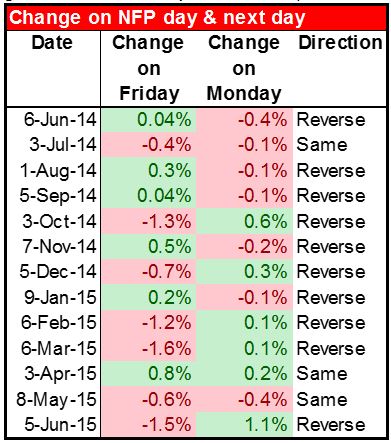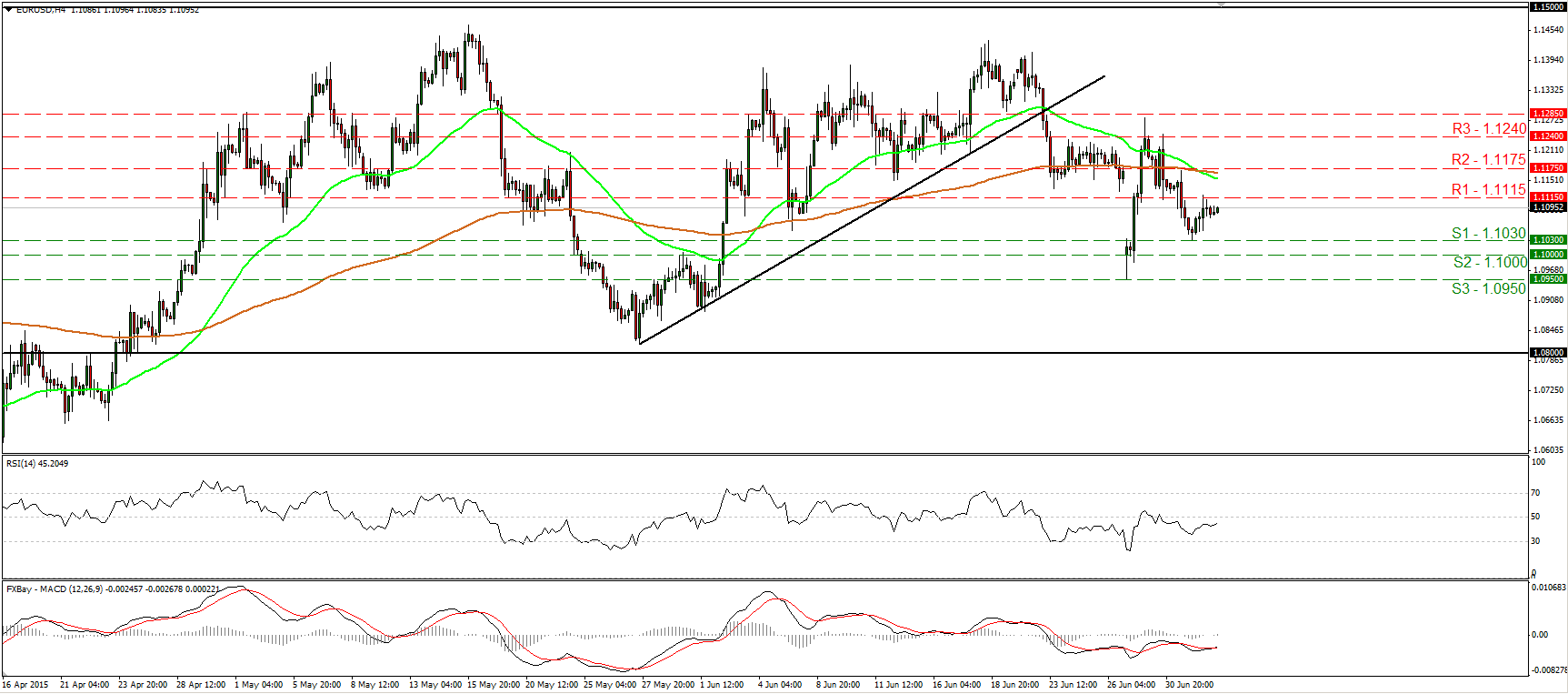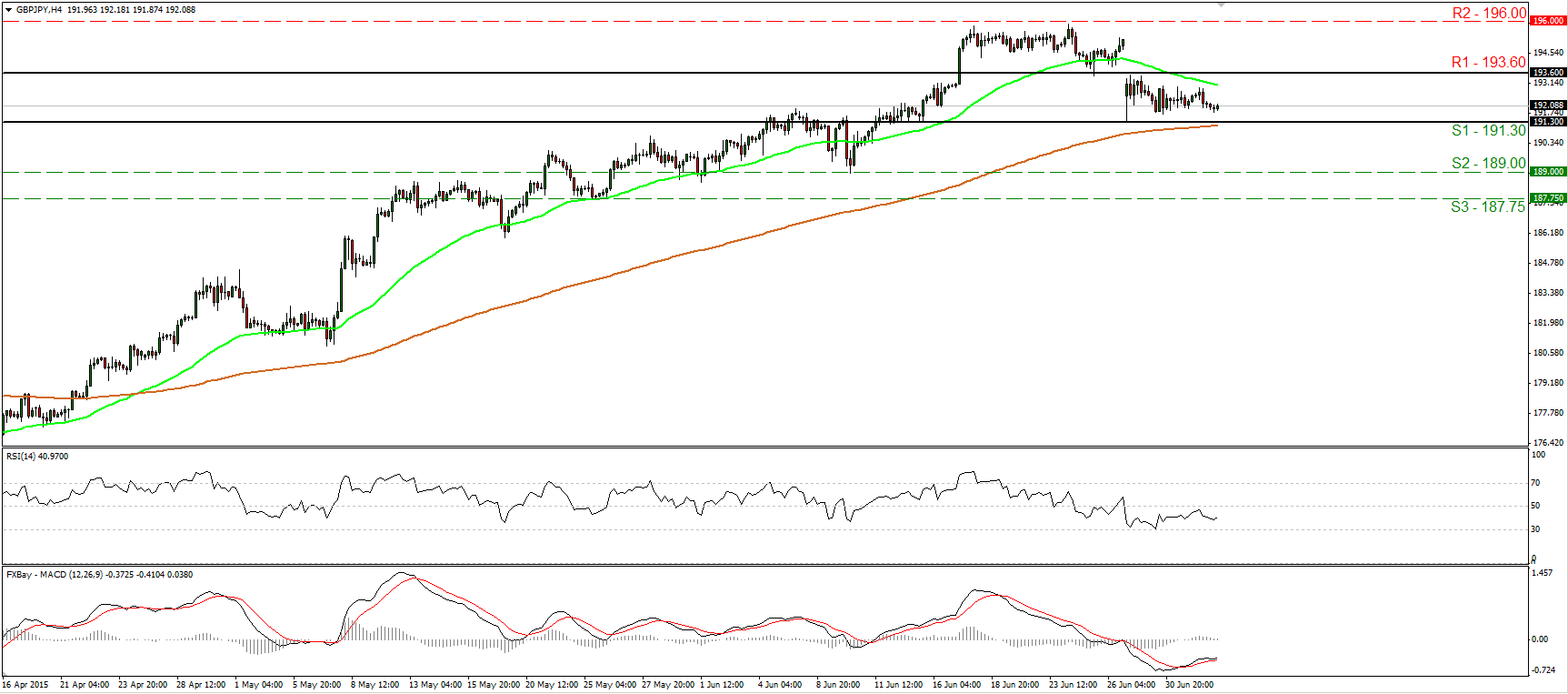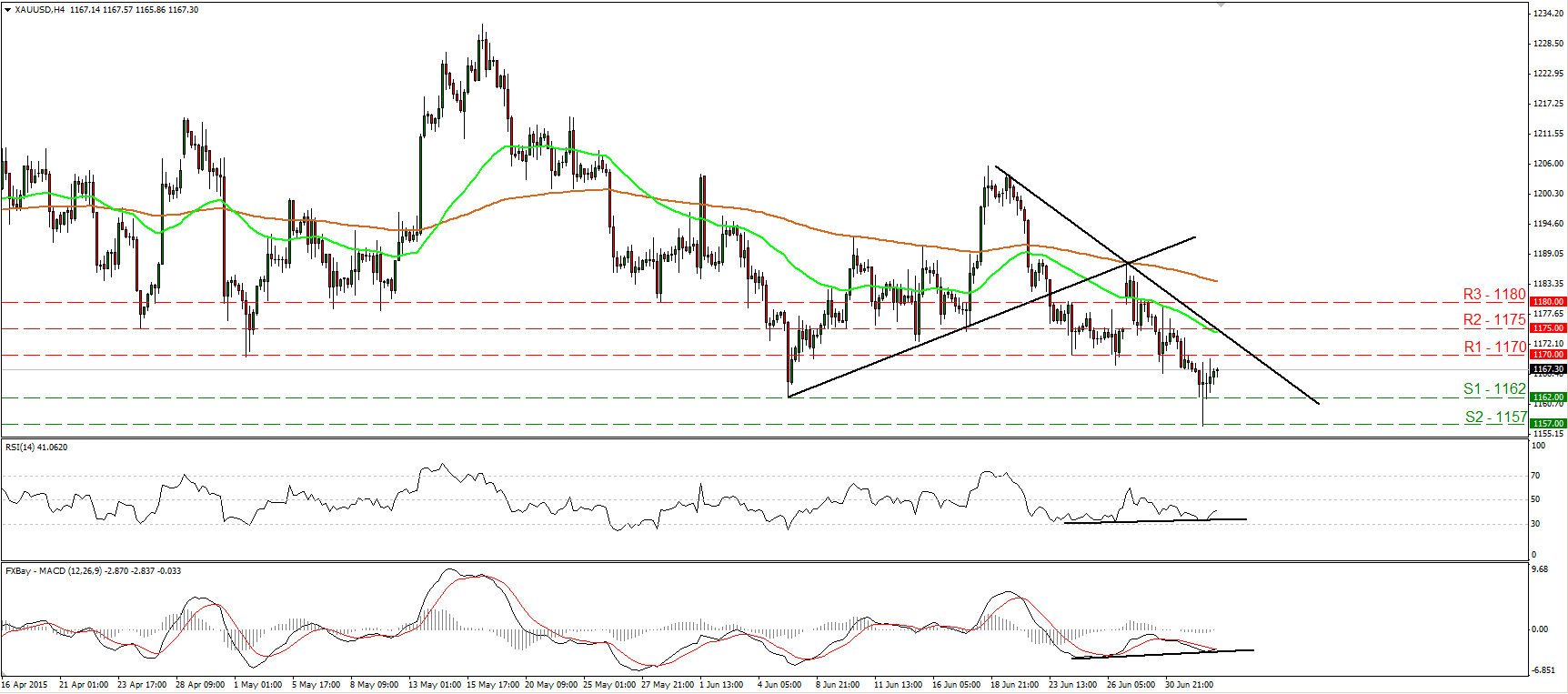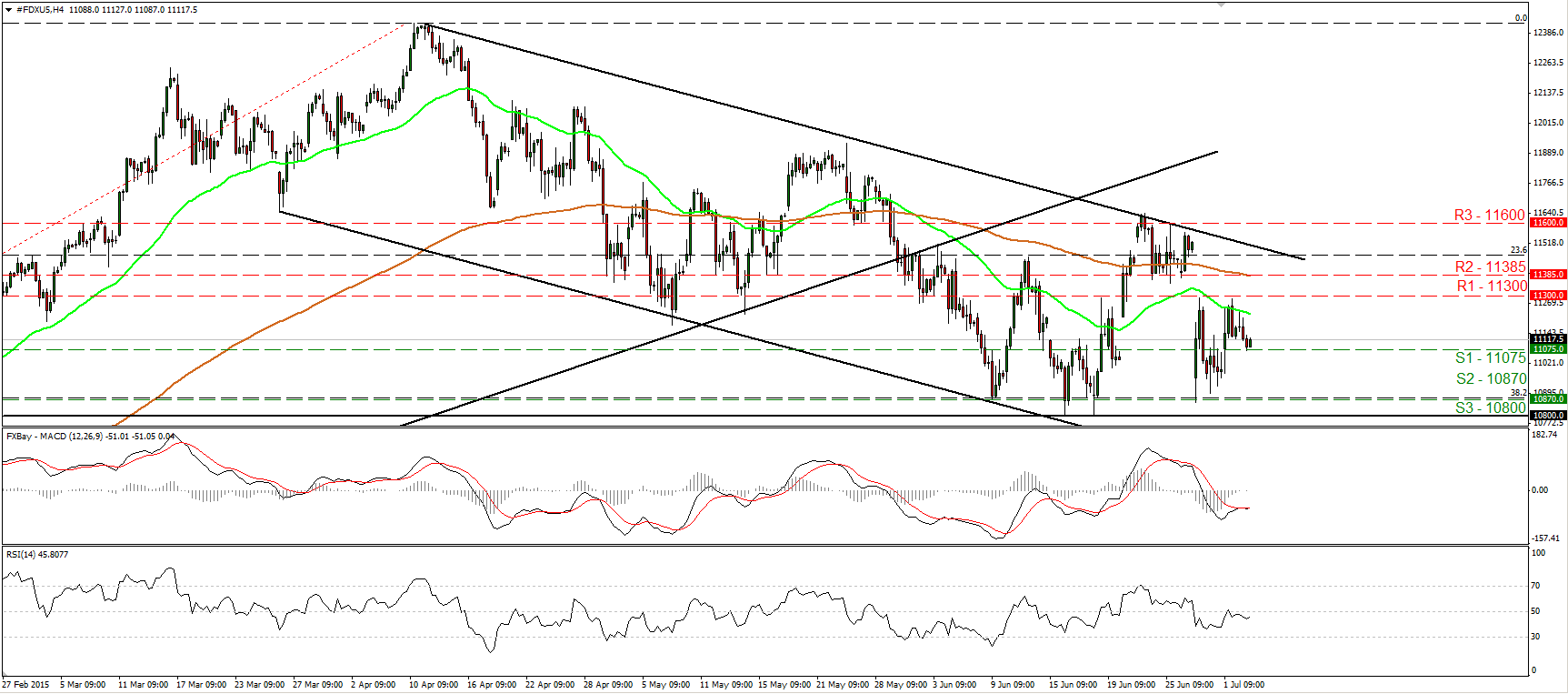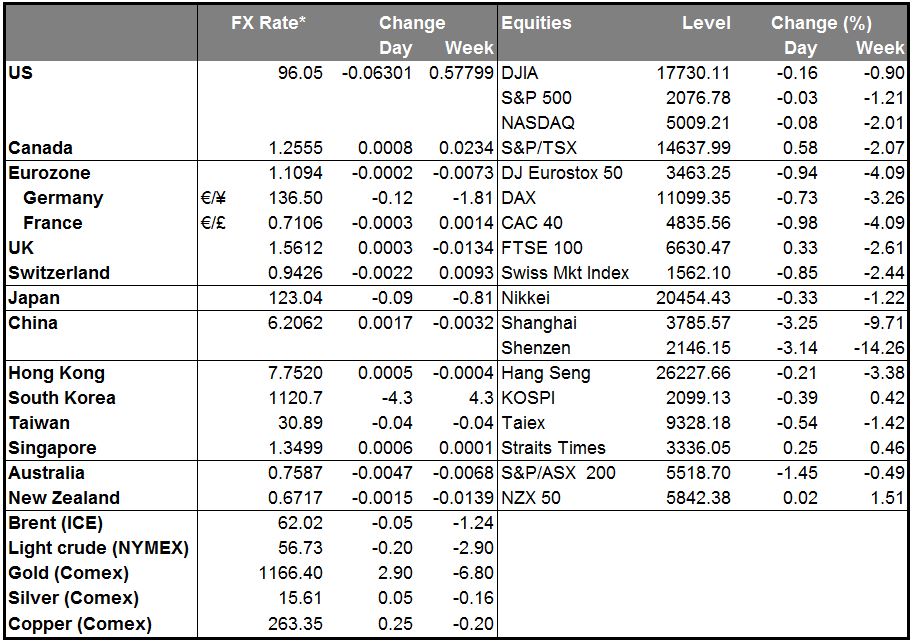• Data does still matter Although the markets have been obsessed with Greece recently, it seems that the economic data does occasionally still matter. After the strong ADP report on Wednesday, the market had been expecting a higher-than-expected nonfarm payroll figure (if that makes sense), but in the event, the payrolls were a bit lower than expected and prior months were revised down. The unemployment rate did fall more than expected, but that was due to a plunge in the participation rate (although there were some technicalities here related to the timing of the reference week). Fed funds rate expectations fell – end-2016 was down 5 bps at the close – and Treasury yields declined too, as investors covered short positions ahead of the long weekend. As a result, the dollar was down slightly against most currencies.
• But remember that the recent pattern has been mean reversion following the NFP figures: that is, a rise on NFP day is often followed by a fall the following day, and vice-versa. So a weak dollar yesterday on the back of the NFP figure does not necessarily mean a weak dollar today. Of course, past performance is no guarantee of future performance.
• SEK, AUD and NOK weaken The exceptions to the weak dollar story were SEK, AUD and NOK. SEK was lower after the Riksbank unexpectedly cut rates at its meeting on Thursday. AUD was down after May retail sales disappointed this morning, rising only 0.3% mom instead of +0.5% as expected. Iron ore exports hit a record in June, but this was no cause for celebration, as it just means that the price fell further. Shipments in June were up 14% yoy, but prices at the end of the month were down 41% yoy, meaning that the total amount of money coming into Australia fell sharply. Meanwhile, the economy still hasn’t successfully transitioned away from mining-led growth, so there is not that much to take over as income from mining falls. Nor was the currency helped by fall in the HSBC China service-sector PMI and composite PMI for June. It seems like a perfect storm for AUD – I expect it to fall further as the Chinese economy weakens and RBA cuts rates to ease the transition away from dependency on mining.
• It’s not clear exactly why NOK is lower, but with oil prices falling again yesterday it doesn’t surprise me. The sharp fall in the manufacturing PMI on Wednesday to a dismal 44.0 gave a negative bias to NOK – like Australia, here’s another country whose commodity exports are falling in price while the non-commodity sector struggles. That implies a weaker NOK too.
• Sunday’s referendum is too close to call The key point in the market, of course, will be Sunday’s referendum in Greece. The polls suggest that people are starting to lose their courage. As they see that being closed off from the EU means no euros coming out of the ATMs, the percent of people who say they’ll vote “no” is falling and the “yes” is rising. Nonetheless, it’s too close to call, and after the disastrous results of the polls in the UK this year, nobody would trust the polls anyway. The key thing is that whether they vote “yes” or “no,” the problems will still drag on. That means there’s plenty of room for volatility next Monday!
• The constraints surrounding the negotiations When thinking about the possible scenarios after the referendum, one has to keep in mind two facts: 1) Greece is voting on whether to accept an offer that is no longer on the table, and 2) the existing bailout package from the European Stability Mechanism (ESM) has expired, and they will need to negotiate a new one. It’s relatively easy to get an existing bailout package renewed, which is what Greece was trying to do previously. It just requires one approval by eurozone governments. But a new bailout package requires two decisions, each of which requires parliamentary votes in several countries, including Germany. That takes time, which they don’t really have. It also takes goodwill on the part of the other countries, which they also don’t have.
• They don’t have time because the real, final, this-is-it deadline is July 20th, when two Greek bonds that the ECB holds totaling EUR 3.5bn mature. If Greece fails to pay the ECB, then the ECB is not going to keep this charade going. It’ll have to stop funding the Greek banking system, which means basically that the banks collapse and Greece has to institute a new currency. That means Greece has to legislate for and implement the entire reform program before July 20th, and win approval for it from other countries so that it has the money to repay the ECB.
•If there’s a “yes” vote: The Finance Minister has said he would resign and the PM has hinted that he would, too. In any event, whoever is in office would immediately restart negotiations. A new government might be received more warmly in other capitals and have more chance of success than the incumbents. Nonetheless, negotiations will be difficult. The Greek economy has deteriorated considerably just in the last few weeks, so any new agreement would probably have to be harsher than the previous offers.
• The immediate attention will focus on getting the ECB to increase its Emergency Liquidity Assistance (ELA) aid to the banking system so that the banks can reopen, and negotiating a new bailout with the ESM. A new bailout will require new commitments on fiscal consolidation, structural reform, debt relief, bank recapitalization, etc. It will also require the involvement of the IMF. That’s a lot to get done – and get the necessary parliamentary approvals – in two weeks.
• If the PM doesn’t resign, then the issue of credibility comes up. After all this, will the creditors trust PM Tsipras to implement even harsher conditions than the ones he rejected?
• If there’s a “no” vote The administration has said that they would restart negotiations, but will the creditors negotiate with them again? And if the government received a mandate to reject the previous offer, they’re not likely to accept a new one with harsher conditions.
• Several – but not all – EU officials have said that a “no” vote would be tantamount to a decision to leave the Eurozone. The ECB might decide to cut off its ELA funds to the Greek banks on Sunday night, meaning the Greek banks might not have any euros to dispense on Monday morning. A SYRIZA insider told the FT that in case of a “no” vote, Greece might choose to end negotiations, leave the euro of its own accord and readopt the drachma – contrary to what Tsipras has said.
• On the other hand, they might just continue the kind of acrimonious negotiations that were taking place before the announcement of the referendum. In that case, with negotiations deadlocked and the banks still closed, a number of MPs might get fed up and leave the coalition. That could make room for a new administration to come in and reach some agreement. But again, time is limited.
• Market is still hopeful I think the market still believes that something is going to save day, probably that they’re going to vote “Yes.” The one-month risk reversal actually moved up on Wednesday and Thursday, indicating less demand for protection against a plunge in EUR/USD. And in any event, it’s still higher than it was back in February.
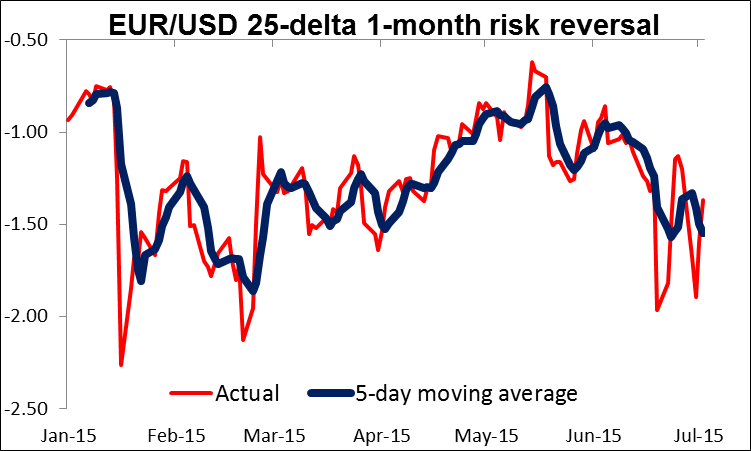
•Today’s highlights: The day is rather light on data as the US markets are closed. The main events on the schedule are the final service-sector PMIs from the countries we got the manufacturing PMIs from on Wednesday. During the European day, we get the final service-sector PMIs for June for France, Germany and Eurozone as a whole. As usual, the final forecasts are the same as the initial estimates, thus the market reaction could be limited, unless we have a huge revision from the preliminary figures. Eurozone’s retail sales for May are coming out as well.
• From Norway, the official unemployment rate for June is expected to tick up a bit. This could weaken NOK somewhat.
• The UK service-sector PMI is forecast to have increased to 57.5 in June from 56.5 in May. After the decline in the country’s manufacturing PMI and the rise in the construction PMI, a rise in the service-sector PMI is needed to keep the confidence up for a rebound in Q2 growth.
The Market
EUR/USD rebounds and hits the resistance of 1.1115
• EUR/USD continued its rebound following the below-estimate nonfarm payrolls print. Nevertheless, the rebound was halted near the 1.1115 (R1) resistance hurdle. I still believe that the short-term bias is somewhat negative, and I would expect the bears to eventually take charge and pull the trigger for another test at the 1.1030 (S1) support barrier. But our short-term oscillators indicate that before the next negative leg, there is still the possibility for further rebound. The RSI is pointing up and is headed towards its 50 line, while the MACD has bottomed and crossed above its trigger line. In the bigger picture, I would maintain my neutral stance. I believe that a move above the psychological zone of 1.1500 is the move that could carry larger bullish implications, while a break below 1.0800 is needed to confirm a forthcoming lower low on the daily chart and perhaps turn the overall bias back to the downside.
• Support: 1.1030 (S1), 1.1000 (S2), 1.0950 (S3)
• Resistance: 1.1115 (R1), 1.1175 (R2), 1.1240 (R3)
GBP/JPY trades in a consolidative manner
• GBP/JPY continued trading in a consolidative manner on Thursday, staying between the support barrier of 191.30 (S1) and the resistance of 193.60 (R1). Having that in mind, I consider the short-term picture to be neutral. However, given the proximity to the lower bound of the range and taking a look at our short-term oscillators, I believe that the forthcoming wave within the range will be positive. The RSI, although below 50, has turned up again, while the MACD, although negative, stands above its trigger line and points somewhat north. On the daily chart, the pair is trading well above both the 50- and the 200-day moving averages, while on Monday, it hit support at 191.30 (S1), which lies slightly above the 23.6% retracement level of the 14th of April – 23rd of June advance. These technical signs support the idea that the short-term uptrend that started back on the 14th of April is still intact and that it could resume at some point in the foreseeable future.
• Support: 191.30 (S1), 189.00 (S2), 187.75 (S3)
• Resistance: 193.60 (R1), 196.00 (R2), 197.00 (R3)
AUD/USD breaks below 0.7600
• AUD/USD tumbled today during the Asian morning after Australia’s lower-than-expected retail sales for May. The pair fell below the key support (now turned into resistance) barrier of 0.7600 (R1), and as a result, I would now expect the bears to initially target the 0.7550 (S1) line, defined by the lows of the 13th and 14th of April. Our short-term oscillators detect negative momentum and amplify the case that the pair is likely to continue trading lower. The RSI turned down and could challenge again its 30 line, while the MACD stands below both its zero and signal lines and points down. As for the broader trend, I believe that a break below the psychological zone of 0.7500 (S2) is the move that would trigger the continuation of the prevailing longer-term downtrend.
• Support: 0.7550 (S1), 0.7500 (S2), 0.7450 (S3)
• Resistance: 0.7600 (R1), 0.7650 (R2), 0.7740 (R3)
Gold dips below 1162
• Gold fell below the 1162 (S1) barrier, but fell short of reaching the 1153 (S3) line, defined by the inside swing high of the 18th of March. The precious metal hit support at 1157 (S2) and then rebounded to trade back above the 1162 (S1) line. As long as the metal is trading below the short-term uptrend line drawn from the low of the 5th of June, I would consider the short-term picture to stay somewhat negative. However, given our momentum signs, I would take to the sidelines for now. The RSI rebounded from slightly above its 30 line, while the MACD has bottomed and appears ready to move above its trigger line at any time. What is more, there is positive divergence between both these indicators and the price action. On the daily chart, although we had a move below the prior low at 1162 (S1), yesterday’s candle looks like a hammer, which could hint at a further rebound. This is another reason I prefer to stay flat and wait for more actionable signals that the downtrend is back in force.
• Support: 1162 (S1), 1157 (S2), 1153 (S3)
• Resistance: 1170 (R1), 1175 (R2), 1180 (R3)

